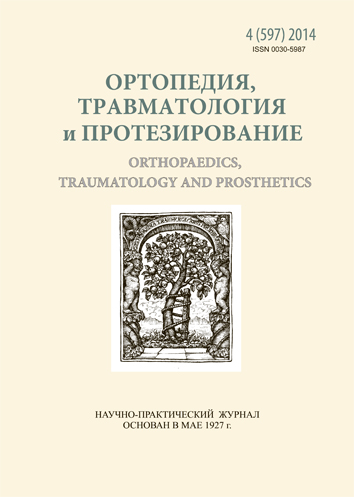Clonogenic activity of bone marrow stromal stem cells in bones of the elbow joint in patients with rheumatoid arthritis
DOI:
https://doi.org/10.15674/0030-59872014441-46Keywords:
rheumatoid arthritis, upper extremity, clonogenic bone marrow activityAbstract
Rheumatoid arthritis (RA) affects about 1 % of the world population. In the debut of the disease of the joints lesions of the upper extremity they observe in 70 % of cases, and the elbow joint — in 5–20 %. Objective: To study the regenerative potential of bone tissue in RA patients with lesions of the upper extremities and on the basis of study of activity of bone marrow stromal stem cells (BMSSC) to justify tactics of surgical treatment. Methods: cultural, statistical. Results: The growth of colonies of BMSSC in RA patients with lesions of the elbow joint registered only in 5.9 % of cases. The cloning efficiency of fibroblast colony-forming units of bone marrow of the humerus in RA was only 0.33 which is 20 times lower than in analogous one for the fracture of the humerus — (32,7 ± 2,5). Besides this 1 sm3 of spongiosa of the humerus contains nucleated cells 2.9 times greater (p < 0.05) than in the ulna (0,315 ± 0,111 vs. 0,110 ± 0,021, respectively). When cloning BMSSC bacterial pro-growth recorded an average in 47 % (8 of 17) cultures of spongiosa of the humerus and ulna. Satisfactory outcomes of surgery (biological arthroplasty and corrective osteotomy) for restoration function of the upper extremity in RA can not be provided by BMSSC spongiosa of the humerus and ulna with low clonogenic activity. Conclusion: In patients with RA clonogenic activity of BMSSC of the humerus and ulna is sharply reduced. Contamination by microorganisms of periarticular tissues and spongiosa of the bones of the elbow joint significantly hinders the process of bone remodeling in patients with RA. Results of this study allow us to make a tentative conclusion that the arthroplasty is the most promising method of orthopedic treatment of RA patients with lesions of the elbow joint which will allow to restore function of the upper limb in better way and to improve quality of life in these patients.
References
- Bleicher M. New frontiers in bone research: Editorial triangle sandoz / M. Bleicher // J. Med. Sci. — 1988. — Vol. 27 (1/2). — P. 1–3.
- Construct validity and reliability of the disability of arm, shoulder and hand questionnaire for upper extremity complaints in rheumatoid arthritis / E. E. Raven, D. Haverkamp, I. N. Sierevelt [et al.] // J. Rheumatol. — 2008. — Vol. 35 (12). — P. 2334–2338. doi: 10.3899/jrheum.080067.
- Matteson E. L. Current treatment strategies for rheumatoid arthritis / E. L. Matteson // Mayo Clin. Proc. — 2000. — Vol. 75. — P. 69−74.
- Seyfer A. E. Indications for upper extremity surgery in rheumatoid arthritis patients / A. E. Seyfer // Semin Arthritis Rheum. — 1993. — Vol. 23 (2). — P. 125–134.
- The patient-based outcome of upper-extremity surgeries using the DASH questionnaire and the effect of disease activity of the patients with rheumatoid arthritis / H. Ishikawa, A. Murasawa, K. Nakazono [et al.] // Clin. Rheumatol. — 2008. — Vol. 27 (8). — P. 967–973. doi: 10.1007/s10067-007-0830-8.
Downloads
How to Cite
Issue
Section
License
Copyright (c) 2014 Sergey Gerasimenko, Lesya Panchenko, Andrey Babko

This work is licensed under a Creative Commons Attribution 4.0 International License.
The authors retain the right of authorship of their manuscript and pass the journal the right of the first publication of this article, which automatically become available from the date of publication under the terms of Creative Commons Attribution License, which allows others to freely distribute the published manuscript with mandatory linking to authors of the original research and the first publication of this one in this journal.
Authors have the right to enter into a separate supplemental agreement on the additional non-exclusive distribution of manuscript in the form in which it was published by the journal (i.e. to put work in electronic storage of an institution or publish as a part of the book) while maintaining the reference to the first publication of the manuscript in this journal.
The editorial policy of the journal allows authors and encourages manuscript accommodation online (i.e. in storage of an institution or on the personal websites) as before submission of the manuscript to the editorial office, and during its editorial processing because it contributes to productive scientific discussion and positively affects the efficiency and dynamics of the published manuscript citation (see The Effect of Open Access).














